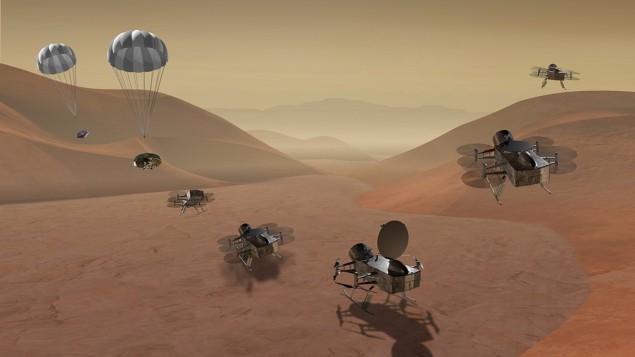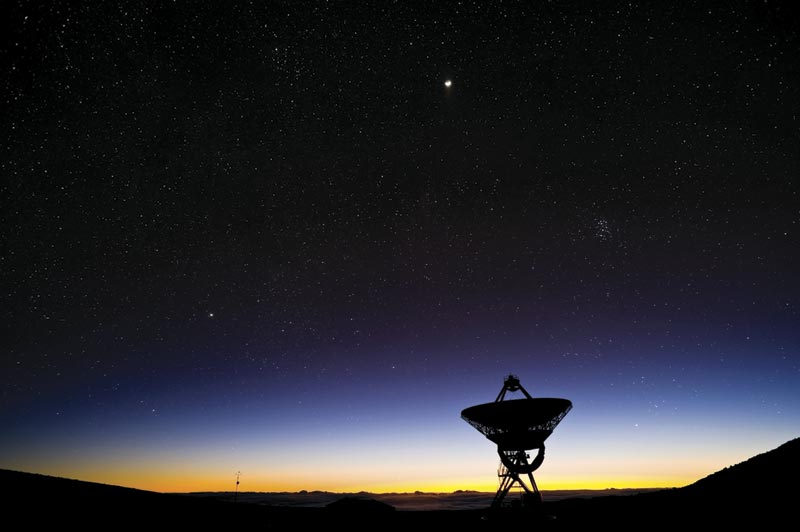
From AbSciCon 2019 in Bellevue, Washington
Yesterday was day four of the Astrobiology Science Conference 2019 and the big news was NASA’s announcement that it will go ahead with the Dragonfly mission to explore Saturn’s moon Titan. The mission will launch in 2026 and arrive at Titan in 2034.
I watched the announcement on NASA TV with a few hundred others in the plenary ballroom at the conference hotel. A huge cheer went up as soon as Dragonfly was mentioned. Dragonfly was chosen over the proposed CAESAR comet sample-and-return mission and Dragonfly seemed the clear choice of the astrobiology community. This is not because CAESAR was uninteresting or unworthy, but because the idea of a drone flying around Saturn’s moon Titan, sampling the soil and atmosphere, was just too sweet and too romantic to resist. And space explorers are nothing if not romantic.
Now, on to the most exciting session I’ve attended so far – it was on Wednesday and was about “technosignatures.”
Astrobiologists are interested in signs of life – they call them “biosignatures” – and how these signs might arise and be detected in places like Mars, Titan and planets surrounding distant stars. I wrote about some of that in a previous blog from the conference.
Intelligent, advanced, and technologically capable
But what the public really want to see, according to one scientist here, are “technosignatures”. These are signs that intelligent, advanced, technologically capable beings exist (or existed) on another planet. Given the popularity of Star Wars, Star Trek and more recently, The Expanse, who could disagree?
Technosignatures could include evidence of megastructures – such as a Dyson sphere – surrounding a star or planet. (Hopefully you followed the saga of Tabby’s Star.) Other planetary technosignatures could include indications of artificial illumination (especially on the planet’s night side), or detection of waste heat from technological processes. Also fair game are urban heat islands, unusual shapes on the surface of a planet – perhaps like Dubai’s famous Palm Islands – or unusual albedo maps. And, of course, listening for electromagnetic signals from a planet, which is something the SETI community has been doing for years (albeit in a blunt fashion at relatively low bandwidth).
Some scientists here think that we are on the verge of being able to detect evidence of extraterrestrial technologies today, if they’re out there. Thomas Beatty, an astronomer at the University of Arizona, said “we are very close to detecting technosignatures from exoplanets” with today’s telescopes – or the next generation of instruments.
Bright lights, alien city
The proposed telescope LUVOIR could, he said, see nighttime lights (from cities) on an planet around Proxima Centauri, the closest star to Earth, only 4.3 light-years away in only 100 hours of observing time. Proxima Centauri is an M dwarf that has the exoplanet Proxima Centauri b in its habitable zone, where liquid water could exist. Svetlana Berdyugina at Albert-Ludwigs University of Freiburg in Germany talked about processing light signals to begin to distinguish potential large-scale land continents amidst an ocean background.
Imaging continents on other worlds. I don’t know about you, but that blows my mind. Check-out Berdyugina’s 2017 talk for more on this topic.

The eerie silence
Other speakers want to use machine learning to pluck meaningful information from the immense streams of data that are, and increasingly will be, beamed back from scientific instruments and missions.
This has been one of the best, most interesting conferences I’ve ever attended in my 20 years as a science writer. Amidst all the talks and science, there has been a real sense of adventure, of pure curiosity wanting to know what is out there. The possibilities for this field seem almost endless, as large as the universe itself.
Dragonfly lands in 2034. What will come after that is being dreamed and discussed at conferences just like this one. I’m coming back next year.



